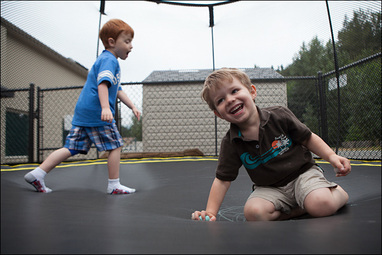Erica Bigler, an occupational therapist at the Lakeside Center for Autism, said students who use the trampoline show increased muscle and bone strength and cardio endurance. "They have improved balance and kinesthetic awareness".
 Trampolines helping kids with Autism reach new heights
Trampolines helping kids with Autism reach new heights Newton’s mother Deirdre believes her son’s desire to jump is a consequence of his autism. And, she’s found an appropriate place for him to jump as much as he wants without hurting himself or others: a trampoline.
Autism spectrum disorder is a range of complex neurodevelopment disorders
characterized by social impairments, communication difficulties and restricted,
repetitive and stereotyped patterns of behavior.
The Lakeside Center for Autism in Issaquah uses a trampoline, donated by Springfree
Trampoline, to help children with autism. The trampoline is used
for speech, occupational, physical and behavioral therapies.
Erica Bigler, an occupational therapist at Lakeside, said students who use
the trampoline show increased muscle and bone strength and cardio endurance.
They have improved balance and kinesthetic awareness.
Bigler works with a 5-year-old boy who came to the center with poor core
strength. He would trip and fall often during therapy sessions until he started
jumping on the trampoline.
“You can see quite a difference in how he can control his body more
effectively,” Bigler said.
The same student had poor social skills, like many other children with
autism. But, Bigler said when kids jump together on a trampoline they share an
enjoyable activity and develop increased body awareness around their peers.
“He typically prefers isolated play, but when he’s on the trampoline he’s
having such a good time,” Bigler said. “It’s one of the only places I see him
interact with a peer and sustain attention on a game.”
Speech therapists at Lakeside use the trampoline as a motivational tool,
allowing children to play on the trampoline if they speak or repeat a word.
“He’ll do amazing things for the trampoline,” Deirdre said of Newton.
Teachers also use the trampoline to teach students how to follow directions by
playing games, such as “Simon Says.”
Children with autism tend to learn more effectively when they are able to
reinforce their intellectual development with physical movements, so staff
members at Lakeside often write words on the trampoline with chalk and ask
students to jump from one word to another to form a sentence.
“It’s amazing what kids on that spectrum can do on a trampoline that they
might not have been able to without that sensory input,” Bigler said. “You see
kids going from disengaged and non-communicative to making eye contact and being
more aware of what’s going on.”
While Deirdre said Newton is often under-stimulated, the trampoline offers
him an outlet to expel his energy and has improved his concentration.
“When he’s [frogging] at Lakeside they can move it to an appropriate
environment,” she said. “We’re not denying it to him but giving him an
appropriate framework.”
But, kids at the Lakeside Center for Autism are not the only ones reporting
life-changing results; adults living with autism in the community are also
benefitting from trampolines.
Anabelle Listic, a 28-year-old Seattle woman with autism has two
trampolines at home and uses them daily to process information and cope with
anxiety.
“My moments of true clarity always happen when I’m on my trampoline,” Listic
said. “It’s like meditation to me.”
When Listic temporarily moved to Oregon years ago, she brought a trampoline
with her instead of a bed.
“I don’t ever want to have to live without jumping on a trampoline,” she
said. “When I’m on a trampoline everything feels effortless and makes sense and
feels okay.”
Listic even took her trampoline on a light rail train once. A friend had
invited her to the opening of his art exhibit but Listic was feeling anxious
about the event. So, she brought a 48-inch trampoline on the light rail and into
the gallery.
“I was either going to bring it with me or not go,” Listic said. “It was
incredibly helpful.”
She said just sitting or lying on a trampoline can help people with
autism.
“Sometimes I just lie on my trampoline and pound my fists on it. I’m moving
that muscle and it’s self-regulating and soothing. That tiny bit of rebounding
feels safe and comfortable to me.”
Source: Komo News
Written By: Rose Egge
You can watch Listic on her trampoline in this video she made for others with autism:
 RSS Feed
RSS Feed
